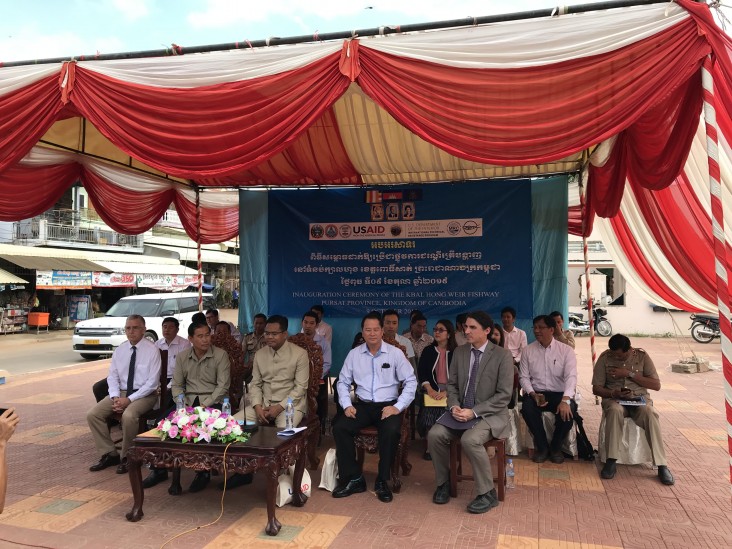Speeches Shim

- Your Excellency Pursat Governor Mao Thornin
- Fisheries Administration Director General Eng Cheasan
- Deputy Governor Cheng Lay,
- Ministry of Agriculture Forestry and Fisheries Under Secretary of State Khun Savoeun
- Inland Fisheries Research and Development Institute Deputy Director Chann Aun Tob
- Members of the Pursat community
Choom Reap Sue!
As a representative of the U.S. Agency for International Development, I am honored to join you today to celebrate the completion of the first fishway on the Pursat River.
Since I arrived in Cambodia I have been reminded again and again of the importance of fish to millions of the Kingdom’s citizens and what a central role fish play in the nation’s diet and its economy. Nowhere is this more evident than here in the Tonle Sap Watershed.
Cambodia faces great challenges in preserving its rich fish populations. Water availability and timing are becoming increasingly uncertain here and throughout the Mekong Basin as hydroelectric development expands. Flooded forests are being removed. More people are fishing, both legally and illegally. And a changing climate adds uncertainty to all of these factors.
But I have also learned that Cambodians – both in government and in communities across the nation – are responding to these threats through community-based fishery management, improved law enforcement, and efforts to blend rice culture with aquaculture.
Today we see the result of your government’s recognition that barriers such as weirs and dams, while providing important benefits to agriculture and flood control, also disconnect fish habitats, limiting the ability for fish to move up and down stream to spawn, rear, and survive dry seasons. Less connectivity up and down your rivers results in less fish, and less fish impacts everyone.
Cambodia and neighboring nations have thousands of weirs such as this one, with more being constructed each year. But techniques are available to greatly reduce the impacts of these structures on fish populations.
This fishway was conceived, designed, and constructed by the Ministry of Agriculture, Forestry, and Fisheries using Cambodian contractors. The work – which was done in partnership with the Governments of Australia and the United States – has already provided passage to more than 70 species of fish. It demonstrates that with careful planning, irrigation infrastructure development and fish conservation and restoration can go hand in hand, benefitting all. I hope that this fishway is only the first of many to be constructed here on the Pursat and throughout Cambodia’s rivers.
As a result of these efforts, we have seen thousands of fish return to the Pursat River, which will enable Cambodians along this important river to get more access to nutritious fish for themselves and their families. The U.S. government is pleased to celebrate this joint achievement as it is yet another step in Cambodia’s journey to self-reliance.
In closing, I offer my sincere compliments to those who have worked, literally day and night, to construct the fishway and to monitor its success. I am excited to tour the site, learn more about how it functions, and see some of the unique fish species that use it.
Thank you.
Related Speeches
- Remarks by Menglim Kim, Project Management Specialist, USAID/Cambodia, USAID Greening Prey Lang Final Youth Debate
- Remarks by Ms. Hanh Nguyen, Deputy Mission Director USAID/Cambodia, Health Professional Councils’ Strategic Planning Orientation Workshop
- Remarks by John Eyres, Director, Office of Public Health and Education, USAID/Cambodia, Dissemination Workshop of the Fifth National Strategic Plan for a Comprehensive & Multi-sectoral Response to HIV & AIDS in Cambodia

Comment
Make a general inquiry or suggest an improvement.